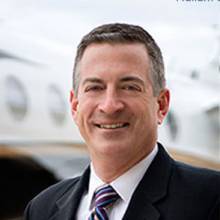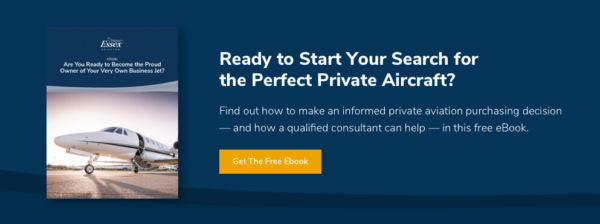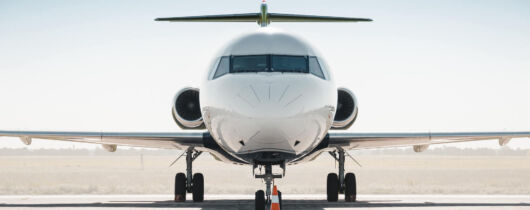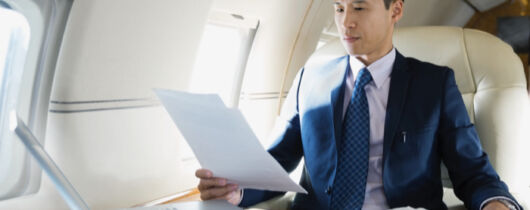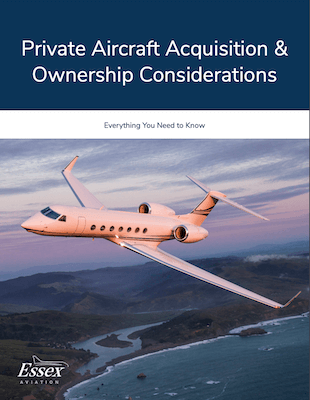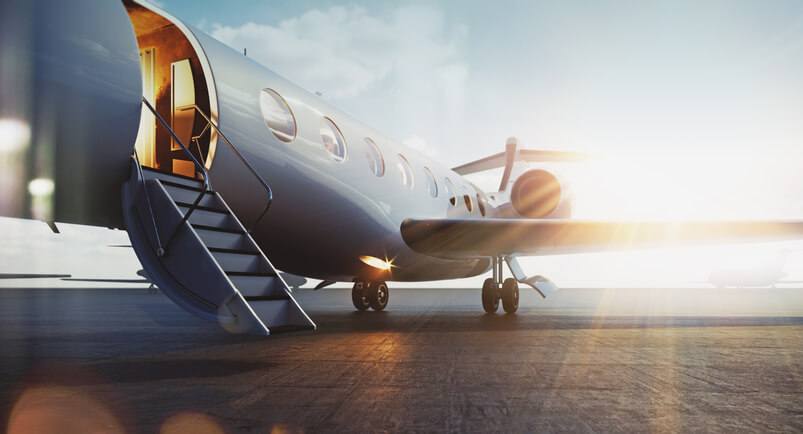
For many people, the thought of acquiring one’s very own private aircraft is an alluring but distant dream. But for those with the means to do so, purchasing a new or pre-owned private jet opens up a world of opportunity, enabling buyers to travel according to their own schedule, arrive closer to their final destination and avoid the hassle of TSA processing, airline delays, traffic congestion and the inevitable cancellations.
We’ve created this comprehensive guide to assist first-time buyers as they navigate the world of aircraft acquisition and to shed light on how working with a private aviation consultant can help simplify the private jet purchase process.
Private Aviation Options
Although buying a new or pre-owned private jet can be a smart choice, before you proceed it’s important to carefully consider all of the private aviation options available to you.
Other private aviation options include:
- Charter: Private jet chartering is an on-demand service that enables travelers to experience the luxury of private aircraft and the different amenities of various aircraft types. In most cases, chartering arrangements can be made through a primary point of contact or an online process.
Chartering has long been a popular private aviation option because it does not require a significant capital cost upfront or additional fixed costs. With that said, it can sometimes be challenging for travelers to find an available aircraft that meets both their specific needs and fits into their desired schedule.
Travelers interested in exploring chartering options, especially as a frequent solution to travel needs, are advised to partner with a private aviation consultant. A consultant can help them determine whether they’d be best served by working with a charter operator or a charter broker, and then make an introduction with the operator or broker who can best serve their needs.
- Leasing: Aircraft leasing refers to an arrangement in which a lessor maintains legal ownership of an aircraft but the lessee holds possession and operational control of that aircraft throughout the duration of the lease. Leasing is a form of purchasing; it follows a different financial structure than outright purchasing but is the same from an operational standpoint.
Leasing can be an attractive option because, similar to outright ownership, it offers more flexibility than other private aviation options. Those interested in leasing would do well to familiarize themselves with the different lease agreement structures so that they can make an informed decision based on their needs. It’s also best practice to work with a private aviation consultant who can oversee the leasing proposal process, negotiations, contracting and more.
- Membership Programs: With a membership program, travelers agree to a fixed cost per hour at the start of their contract, which is invoiced after each flight. In most instances, travelers are also subject to a monthly or annual membership fee.
Membership programs typically appeal to individuals who want the experience of private aviation but prefer a shorter-term commitment and lower investment cost than fractional or outright ownership. Membership programs often come with considerable advance notice requirements, which may not be an issue for some travelers but does pose a challenge for those who make last-minute travel arrangements.
- Jet Card Programs: There are two types of jet card programs from which travelers can choose. The first is a dedicated service with a predetermined number of hours on a specific aircraft type or size category. The second is a debit card service that — barring certain exceptions — enables travelers to fund an established travel account and select the aircraft category on a trip-by-trip basis with agreed-to hourly rates.
- Fractional Ownership: As its name implies, fractional ownership is a form of ownership in which a buyer purchases a share of a specific aircraft that equates to a specific number of annual allotted flight hours from an aircraft operator. Fractional ownership programs require a minimum share size that equates to 50 hours of flight time per year. In some programs, shares are based on an annual number of days of utilization rather than hours of utilization.
Fractional ownership is the closest thing to outright ownership short of actually buying a private jet. The premise of fractional ownership — as compared to full ownership — is to share not only in the cost of the aircraft itself, but also in general operational costs. These costs come in the form of a monthly management fee for the general staffing and ongoing maintenance of the aircraft.
The fractional program provider is responsible for employing pilots, cabin crew and flight operations coordinators; administering maintenance; covering airport and hangar fees and fleet insurance. These allocated costs are incorporated into the fractional ownership program and paid by the share owner in the form of a monthly management fee. The share owner pays operating costs through an hourly variable and fuel operating cost, to be paid on a monthly basis and is calculated based on the actual hours flown the prior month.
When to Consider a Private Jet Purchase
You may be wondering, “How do I know whether it makes more sense for me to buy a private jet rather than pursue alternative charter, membership or fractional share options?”
There really is no one-size-fits-all answer to that question; each prospective buyer’s situation is unique and will influence their final decision. With that said, a private jet purchase could be a sound investment if:
- You fly frequently enough to justify the investment that ownership requires
- You have specific travel requirements that a dedicated aircraft can support
- You have privacy or security concerns
- Your current travel arrangement no longer meets your particular needs
- You want more control over your travel needs and flight activity
- You simply want to own your own private
If you’re still unsure whether buying a private jet makes sense, you may benefit from talking to a private aviation consultant. An experienced consultant can perform an initial evaluation — including a technical and financial analysis — to help you determine which aircraft and utilization model would best serve your needs and set cost expectations.
Benefits & Barriers to Private Aircraft Ownership
Buying a new or pre-owned private aircraft comes with advantages and disadvantages that should factor into your private jet purchase decision.
These include:
| Pros | Cons |
|---|---|
| Travel in comfort and complete privacy | Capital investment to acquire an aircraft and enter it into service can be significant |
| Enjoy the freedom of flying according to your own schedule | Full responsibility of the cost of operations and ongoing maintenance |
| Avoid the congestion of commercial airline terminals and save valuable time that would have otherwise been spent waiting for flights | Full responsibility for salaries of the flight crew and potentially a maintenance technician and other flight support staff |
| Gain access to a wider range of airports and arrive closer to your final destination | Expect assets to depreciate over time |
| Customize the interior and exterior of your private aircraft according to your aesthetic preferences and choose from a wide array of amenities | Identifying the appropriate aircraft management company is important but time consuming; however, a private aviation consultant can leverage their network of industry connections to help you find a suitable option |
| Explore new opportunities for revenue generation, chartering, and reduce your net operating cost | |
| Enjoy the dependency, consistency and peace of mind that comes with entrusting a dedicated crew to operate your aircraft | |
| Select the cabin management system and other technological systems that best meet your needs |
Buying a New vs. Pre-Owned Private Jet
Once you’ve committed to the idea of purchasing a private aircraft, the next step is to determine whether you want to buy a new or pre-owned private jet.
It’s a common misconception that “used” items are somehow lower in quality than newer objects but there are plenty of high-quality, pre-owned aircraft that can offer many more years of safe and comfortable travel. That said, it’s important to conduct a thorough pre-purchase evaluation and aircraft records analysis before purchasing a pre-owned aircraft.
Although a pre-owned aircraft may require interior and/or exterior refurbishment or touch-ups after closing, the cost of such services is generally offset by the reduced capital investment (relative to the initial investment cost of a net-new aircraft). You can even contract a private aviation consultant to manage and oversee the entire refurbishment process, from reviewing design proposals to arranging final delivery and acceptance of the refurbished aircraft, thereby giving yourself one less thing to worry about.
It’s also possible to complete a pre-owned aircraft purchase transaction and enter the aircraft into service in a matter of months, which can make this option appealing to prospective buyers eager to start flying. By comparison, new aircraft can take anywhere from 12 months or more to acquire and enter into service.
Not that purchasing a pre-owned aircraft is necessarily a better choice than purchasing a new model — but each option offers different advantages based on a client’s needs and objectives.
From a complete design perspective, buying a new private jet gives you the freedom and flexibility to select finishes and amenities for all aspects of the aircraft based on your needs and preferences, often with the added bonus of working with the original equipment manufacturer’s (OEM) in-house design team. Purchasing a new aircraft also means you have access to the latest technology and safety features; in some cases, new aircraft also offer longer ranges and better fuel efficiency that could reduce your operating costs.
Although new aircraft typically require a higher capital investment than pre-owned models, what you spend upfront you will likely save on maintenance costs as certain routine maintenance events will fall under the OEM’s warranty during the initial years of ownership. You’re also less likely to experience issues with parts availability for repairs with a new aircraft vs. a pre-owned one, depending on the age of the pre-owned aircraft in question.
Making Sense of Overall Ownership Costs
There are a number of costs associated with private aircraft ownership beyond the initial purchase price, which, depending on the aircraft, can range dramatically. These costs should factor into your decision process when considering ownership of either a new or pre-owned aircraft.
Ownership cost components will often include:
- Refurbishments (for pre-owned aircraft), which include any interior or exterior design changes and equipment upgrades
- Customization and specialty materials (for both new aircraft and refurbishments)
- Routine inspections, maintenance and repairs
- Hangar storage fees
- Insurance premiums
- Fuel
- Flight crew salaries and training
- Aircraft management (annual fees)
It’s important to factor in these costs when deciding whether to buy a private jet; they typically vary by aircraft model. A qualified private aviation consultant can provide accurate benchmark ownership costs and even detail charter revenue at a given percentage that provides both an hourly and annual budgeted cost.
How to Purchase a Private Jet
For first-time buyers, the general process for purchasing a private aircraft is as follows:
- Retain the services of a qualified aviation consultant. Private aviation consultants bring an unparalleled level of expertise to the table and can offer unbiased advice, which makes navigating the complexities of the acquisition process much easier. Most consultants also have an extensive network of industry connections to draw upon, which enables them to streamline the process and secure favorable terms for their clients.
- Identify your travel requirements. Do you intend to use your new aircraft for business purposes or personal use? Do you typically travel with small groups or large parties? Do you primarily fly domestically, internationally or a combination of the two? Do you require any special accommodations, amenities or even to transport unique cargo that requires larger baggage compartments? Your answers to these and other questions play an important role in determining which aircraft make and model makes the most sense based on your particular situation. Again, a private aviation consultant can conduct a full analysis of your general requirements, flight history and future travel plans to help define your exact needs.
- Establish your budget. How much are you interested in spending on your new aircraft? How much can you allocate for ongoing operational expenses? Conducting a financial analysis can help you gain clarity and define a budget for your private jet purchase.
- Identify the appropriate aircraft make and model. Once you’ve defined your requirements and your budget, you should have all the information you need to make an informed decision about whether you want to purchase a new or pre-owned aircraft, and which make and model would best serve your needs.
- Determine how you intend to manage and maintain your aircraft. Private aircraft owners have the option to either establish their own in-house flight department — which is a common practice amongst large corporations that own private aircraft, especially a fleet of aircraft — or retain the services of a third-party aviation management company that will assume responsibility for ongoing management, maintenance and operational oversight.
- Retain the services of an aviation attorney and tax advisor. In addition to an acquisition consultant, an aviation attorney and a tax advisor who specializes in private aviation should round out your acquisition team. These experts will handle any necessary legal paperwork, help you make sense of complicated, aircraft-specific tax codes and ensure the acquisition process is as smooth as possible.
- Identify a suitable aircraft — either new or pre-owned — that meets your established criteria. This is where the support of a private aviation consultant really comes in handy. For new aircraft, your consultant can interface with OEMs to identify the appropriate aircraft, equipment and options based on your needs. For pre-owned aircraft, your consultant can leverage their network of contacts to find the most suitable candidate within the market — or even one that has yet to be publicly listed.
- Negotiate a purchase agreement. Once you’ve located the specific aircraft you wish to purchase, your acquisition team will work together to complete the necessary paperwork and negotiate a purchase agreement with either the OEM (in the case of a new aircraft) or the seller’s aircraft broker (in the case of a pre-owned aircraft). Your purchase agreement will include specific instructions, protections, payment structure and will outline a final delivery.
- Close on your new aircraft. During closing, your acquisition team will file your closing documents with the appropriate parties (these include the Federal Aviation Administration’s Aircraft Registration Application, FAA Bill of Sale and more) and oversee the final transfer of aircraft title.
- Facilitate final acceptance and delivery and arrange entry (or, in the case of pre-owned aircraft, re-entry) into service. With closing complete, your private aviation consultant will arrange the entry into service of your new or pre-owned aircraft, at which point you’re ready to fly.
Note that the process of designing and deciding the specifications for a new aircraft — which includes complex design, engineering and production phases — can take 12 to 24 months from start to finish.
During the design phase, your private aviation consultant will attend meetings with the OEM’s design team to ensure that all your specifications are implemented. Once that design is approved, the aircraft will enter into production; once again, your consultant will oversee this process in its entirety, providing you with regular updates about the status of your aircraft. The total number of production phases will vary depending on the size of the aircraft, the cabin complexity and any recommended change orders along the way.
By comparison, this process takes roughly 45 to 60 days for pre-owned aircraft, plus any additional time required for refurbishment services. It’s important to note that the pre-owned aircraft acquisition also includes a pre-purchase inspection, during which your private aviation consultant will organize an inspection of the aircraft for any pre-existing damage, potential maintenance issues, Airworthiness Directives and so on so that you can proceed with the transaction with confidence. The pre-purchase inspection typically occurs after the preliminary inspection is complete, and the Aircraft Purchase Agreement is in place.
Questions to Ask Before Purchasing a Pre-Owned Private Aircraft
When buying a new private jet, it’s common to either work directly with the OEM or to have your aviation consultant work with the OEM to select the make and model, communicate your design and customization preferences, and oversee the design and production processes. Since it’s a new asset, there’s no need to perform an evaluation of the aircraft’s history.
Purchasing a pre-owned aircraft is a slightly different story. Once your private aviation consultant has identified suitable options within the pre-owned market, it’s important they ask evaluative questions to ensure that the aircraft is as it is represented to be.
These questions include:
- Why is this aircraft being listed for sale?
- What is the aircraft’s serial number?
- What is the aircraft’s registration number and registration history?
- What is the aircraft’s damage history?
- Are there complete and accessible aircraft maintenance and service records?
- Do the aircraft’s maintenance records indicate unusual or noteworthy gaps of time through its life since entering service?
- Can you provide a complete list of avionics by make and model number?
- What upgrades have been made to the avionics installed?
- What avionics upgrades are necessary?
- What additional equipment was installed on this aircraft?
- When was the aircraft last inspected?
- What is the status of future inspections?
- Does the aircraft’s specifications meet basic Part 135 requirements?
- Who performed that inspection?
- What were the results of that inspection?
- How was the aircraft stored during its ownership history?
Your private aviation consultant will likely cover many of these questions (and more) during the pre-purchase inspection. The answers to these questions will enable you to make an informed private jet purchase decision.
Become a Private Aircraft Owner with Help from Essex Aviation
Are you ready to start your search for the perfect private aircraft? If so, you’ve come to the right place. Essex Aviation Group has helped countless first-time buyers learn about the various options available to them, navigate nuances within the acquisition process and buy the private jet that ideally meets their needs. And with over 70 years of combined experience in the aviation industry, you can count on our team of consultants to provide you with reliable, unbiased expertise every step of the way.
Contact us today to take the first step toward becoming a private aircraft owner.
Private Jet Purchase FAQs
Q: When purchasing private aircraft, how do I know which model is right for me?
A: Regardless whether you’re interested in a new or pre-owned jet purchase, your specific travel requirements are the most important factor in determining which model you choose.
When purchasing new aircraft, competing OEMs may have models available for delivery earlier than others. If time is a significant factor in your decision, you might choose to purchase a model from an OEM offering a shorter delivery timeline. With pre-owned aircraft, you’ll want to carefully review all available models on the market. When doing so, it’s important to have the support of an experienced private aviation consultant who can leverage their network to find suitable listings, will compare all available options against your specified requirements and will deliver unbiased advice at every step of the identification and acquisition process.
Q: How much does it cost to buy a private jet?
A: The answer to this question depends on a variety of factors, including whether you intend to purchase a new or pre-owned aircraft, the size of the aircraft, whether you wish to customize or refurbish your aircraft, whether the aircraft is currently enrolled in a maintenance program and so on. A private aviation consultant can perform an operational cost analysis to help you better understand your total investment.
Q: What financing options are available to me?
A: The most common financing options are outright acquisition (which entails) financing a portion of the acquisition price) and leasing. Whether you choose to acquire and finance or lease your aircraft, it’s important to note that older aircraft can be more challenging to finance than newer aircraft. Again, a private aviation consultant can offer guidance on the most effective means of financing your private jet purchase.



